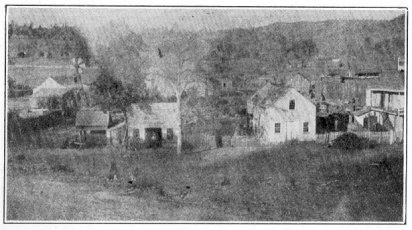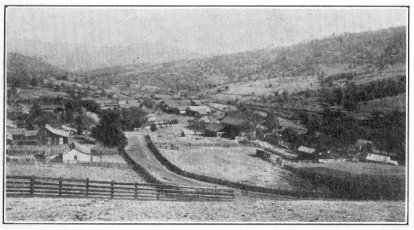
[click to enlarge]
Coulterville in 1858.
At the side of the residence of Jim Shimer, are ladies in hoop skirts.
| Online Library: | Title | Author | California | Geology | History | Indians | Muir | Mountaineering | Nature | Management |
Yosemite > Library > Call of Gold > 27. Mismanagement by Wall Street >
Next: 28. Fremont’s Later Career • Contents • Previous: 26. Fremont’s Sale
The great Fremont Estate in Mariposa County had passed out of the control of Fremont and was now a plaything for Wall Street.
In the latter part of 1863, Trenor W. Park left for the East and Fred Law Olmstead, noted New York architect came to Mariposa as manager for the Mariposa Company.
During Olmstead regime, Mariposa was, without doubt, the most thriving town in the southern mines. After he commenced his extensive work, which added two hundred men to the population, not to speak of the women, there were less rows and generally less violations of the law.
He was not an expert miner and instead of spending the Company’s money to open up the mines, he spent over $200,000 on the surface of the Mariposa mine, in building a fifty-stamp mill and a village of some twenty houses. A foolish tunnel was commenced, and after spending $40,000 on it, he was called home, at the end of two years, and the works upon the Grant stopped.
Bowles, correspondent of the Mariposa Gazette, December 2, 1865, wrote as follows:
“The great Mariposa Mining Company, formed in Wall Street two years ago, with a capital of ten millions, a debt of two millions and not a cent of ready cash, succeeding to General Fremont’s property and his style of doing business, has come to grief.
“It is all a sad, vast ruin, a magnificent gentleman holding his head high but wearing his last year’s clothes and dining around with his friends, a sort of grand land and mine Micawber.

[click to enlarge] Coulterville in 1858. At the side of the residence of Jim Shimer, are ladies in hoop skirts. |

[click to enlarge] Coulterville in 1878. |
“There is doubtless life and value, possibly great wealth in it still, but not of the sort of degree that has been set up for it. Divided up and conducted by private parties or small companies, as the Grass Valley mines are, or managed as a whole, even with an eye to practical results and no side issues as to the Presidency or a grand Wall Street jobbing operation, or the control of California politics depending on it and drawing its life-blood, the Estate may yet have a useful future before it.
“A few men are rich from it here and in the East, but their wealth is more from the sale of stocks and bonds in New York, than the profits of the mines in Mariposa County.
“The illustration of the whole lies best, perhaps, in the sincere boast attributed to its most gallant but never thrifty, original owner, ‘Why’, said General Fremont, ‘when I came to California, I was worth nothing and now I owe two million dollars’.”
J. Ross Browne, eminent mining engineer, in his report to the Secretary of the Treasury of the United States, in 1868, says:
“The monthly production of the quartz mines on the Mariposa Estate averaged in 1860, $39,500; in 1861, $53,500; in 1862, $43,500, which was lower due to the great flood carrying away Benton Mills.
“The average for the first five months in 1863, was $77,000; in May, it was $101,000 and it was at this time that the Estate was sold to an incorporated Company, capitalized at $10,000,000. The prospectus of the Company was alluring and as the stock was put on the market at the time of the San Francisco mining stock fever, it was readily sold. The Company instead of cancelling the debt and taking stock for it, took a mortgage payable in gold and issued the stock subject to this and other large debts, including $130,000 due to workmen. Everything was in confusion.
“The yield for the first five months in 1863, before the sale, was $385,000, with a net profit of $50,000 a month. During the last six months after the sale, the output was only $186,993, with a net loss of $80,000 a month. In 1864, the yield was $465,000 and the expenditures $760,000. As a result, the Company soon afterwards passed into the hands of a receiver.”
Charles G. Yale, another prominent mining man, stated that on some of the Mariposa Estate mines, in 1863, they worked about 65,000 tons of ore averaging $7.77 to $8.05 at a cost of $5 per ton for all expenses, and on one of the mines, when they worked $29 rock, the tailings showed $16 per ton. Professor Ashburner of the State Geological Survey is authority for the statement that seventy per cent of the gold in the quartz worked at Benton Mills was lost.
Next: 28. Fremont’s Later Career • Contents • Previous: 26. Fremont’s Sale
| Online Library: | Title | Author | California | Geology | History | Indians | Muir | Mountaineering | Nature | Management |
http://www.yosemite.ca.us/library/call_of_gold/wall_street_mismanagement.html